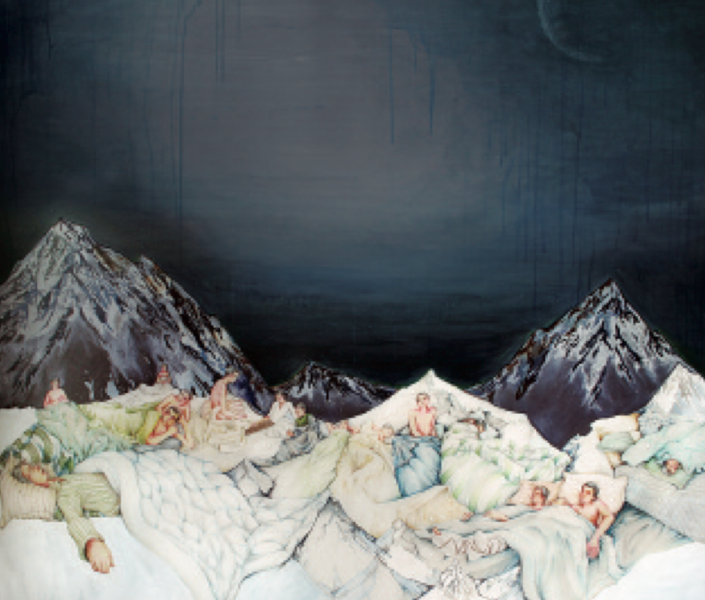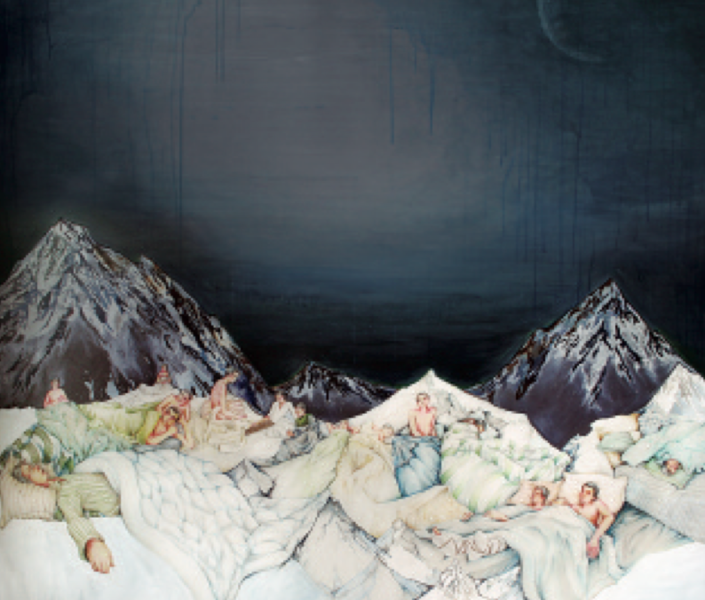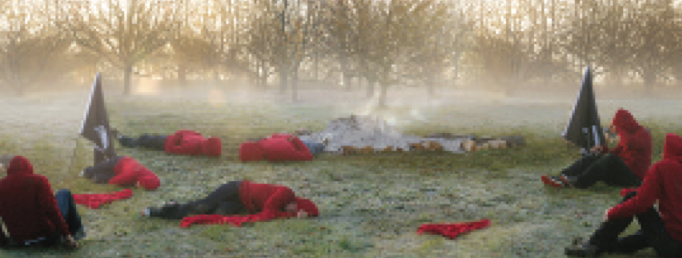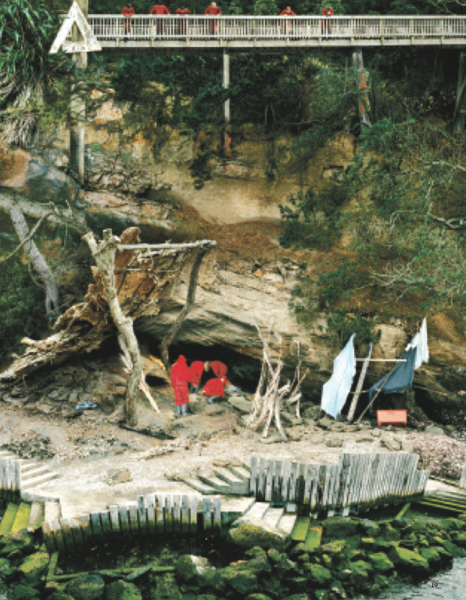Anthony Goicolea
Uncanny Interaction, the Work of Anthony Goicolea
Anthony Goicolea’s entire body of work can be described as a fictional autobiography. Similar to artist Gregory Crewdson, Goicolea creates elaborate mises-en-scènes, painstakingly produced for each work, resulting in moody, sinister stages where his characters interact and create undefined stories. His videos, as well as his photographs, always depict groups of boys engaging in games, or rather, in ambiguous activities: one boy pinning another to a bed and spitting in his face; boys wearing hoods and running scared in a forest; boys cleaning a pool full of floating bodies; a boy obsessively biting his nails; school boys mischievously posing as if in a class photograph; and uniformed boys eating gluttonously around a table. These are among the many examples of boyhood behavior captured by this artist since 1996 in photographs and videos, and most recently, also in installations and drawings.

Upon closer notice, the viewer realizes the boys depicted in these unusual actions are all the same, and in real life, the artist. Goicolea’s youthful looks have been described by many as “uncanny”. Although the artist was born in 1971, with makeup and costume he oftentimes passes for a teenager. This physical trait serves the artist as a tool in an exploration of boyhood themes and behavior. Goicolea, of Cuban-American background, draws less from his cultural heritage, than from gender identity and sexuality issues, especially the ambiguous period of a pre- pubescent and adolescent male and the complex rites of passage in the search for identity, self-esteem and a sense of self.
His Fairy Tale Series, of 1996, sets the stage for an entire oeuvre in which performance, fiction and biography intertwine. This series illustrates each letter of the alphabet with a character or subject from a fairy tale as “performed” by the artist himself. Costumed as twenty- six different characters with almost no background, the artist “borrows” stories familiar to the viewer and he re-enacts them in these photographs. In doing this, he randomly mismatches and distorts these cultural icons and he constructs his own world of hybrids, as explained by him: “I investigate social constructions of age and gender and I allude to taboos of gender role play, adult and childhood fantasies, and conventional ideas of beauty and the grotesque”. This investigation runs through the artist’s entire body of work to this day. In his Self Portraits Series, produced almost simultaneously to the Fairy Tale Series, Goicolea begins to develop more personal narratives as he introduces himself as characters in a variety of questionable childhood actions. I paraphrase an explanation by the artist: At the same time as these characters are perceived as disturbing or disgusting, their bizarre quality and vulnerability achieves in making the viewer sympathetic to them.
Gradually, in his photographs and later in his videos, the artist begins producing narratives that become more and more complex in the interaction between the characters and the scenes. Whether in his photographs, videos, video-installations or drawings, the artist creates tension depicted in actions as if in the middle of happening. Beginning in You and What Army, and following through in Summer Camp Series and Detention Series, Goicolea digitally clones the image of himself in a variety of interacting characters, introducing a narcissistic element in play between his characters. These large-scale, mural format photographs display scenes from summer camps, boy schools, and play dates, for example, in which adolescents publicly role-play in an investigation into sexuality and gender identity. These are often introduced by subtle elements such as school uniforms and props such as canoes or bunk beds, which represent these rites of passage. Although more explicit than in previous works, the narratives in these photographs remain inconclusive to the viewer. Like a voyeur, the viewer has the impression of experiencing something precarious in the middle of happening without knowledge of how it happened or what will occur next. In 2003, Goicolea begins to produce videos. The artist’s virtuous camera-work now translates still images into time-based sequences of movement and action. His narratives continue along his main thematic exploration and his characters digitally clone themselves before our eyes in obsessive activities such as nail-biting and tickling. His stage settings become much more complex and require the production of entire environments for his characters, now in motion. Amphibians, 2003, the most elaborate and ambitious of the early video series, begins with a frightened, red-hooded, uniformed boy running in the forest. As he continues to run, he multiplies and becomes two, then four, then six boys, all running scared away from an imminent danger. As all the boys arrive at a lake, they strip of their shoes and red capes, and in their school uniforms, they jump into the lake and begin swimming. The video then captures the boys swimming underwater, as it comes to an end and loops to the beginning scene.
Staging in Goicolea’s work becomes more important and elaborate in the last two years, and its relative importance vis-à- vis the figures has become heightened. In Kidnap Series and Shelter Series, vast eerie landscapes dwarf the figures and their actions. These works entail very complex actions taking place in scenarios no longer entirely constructed by the artist, but found in nature. In 2005 in Landscape Series, the artist finally and completely eliminates the figures from his photographs, as he focuses only on the settings. This body of work presents lyrical, yet mysterious scenes in which traces of the figure are always insinuated and present. These works are produced alongside works that continue to include figures, but in a more subtle manner than the earlier works. In 2005, Goicolea produced video- installations including elements and stage-like props as if inviting the viewer to experience his video and photograph settings and partake in a theatre-like environment.
In 2005-2006, Goicolea creates drawings of unusual and highly lyrical quality. Formally, these drawings contain an economy of line and the use of subtle colors contrasted by sharp black forms. The artist makes sublime use of negative space throughout. Although figurative, these drawings contain a naïveté that sets them apart from the realistic nature of Goicolea’s early photographs. They seem to allude back to the more personal, fairy- tale works with less information and less narrative structure. These works complete a full circle, as the artist navigates the vulnerable path in which the very personal and the public merge.
Profile
Anthony Goicolea obtained his MFA in sculpture and photography at Pratt Institute of Art (1994-1996), and a BA and BFA from the University of Georgia. He also performed studies at the University of Madrid. He has exhibited extensively in prestigious international venues and is included in permanent collections such as those of the Whitney Museum of American Art, New York, NY; The Museum of Modern Art, New York, NY; The Guggenheim Museum of Art, New York, NY; The Brooklyn Museum of Art, Brooklyn, NY; Yale University Art Collection, Photography, CT; and the Museum of Contemporary Art of Castile and Leon, Spain, among others. He has also been awarded grants and important prizes for his work, most recently the 2006 Cintas Foundation Fellowship in Visual Arts, awarded last month in Miami.







